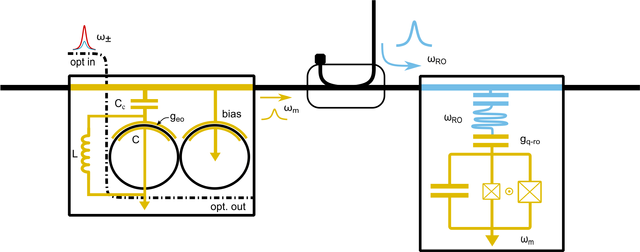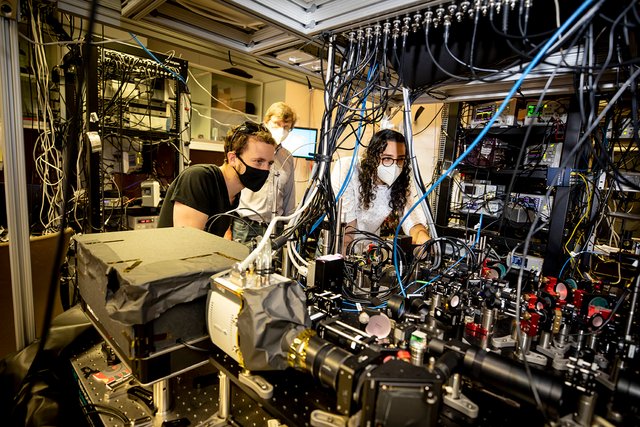New quantum router that converts light into commands for qubits/Nuevo router cuántico que convierte luz en comandos para cúbits

Source
Quantum computing is undoubtedly one of the technologies of the future, with its computing power surpassing even the most powerful current and future supercomputers. However, it is also one of the most complex things humankind has ever been capable of creating. On the one hand, the creation and manipulation of qubits is extremely complex and requires environments free of any disturbances and temperatures close to absolute zero. As if this weren't enough, quantum chips must still communicate with each other without the qubits degrading.
La computación cuántica es sin duda una de las tecnologías del futuro por su capacidad de cálculo que deja en ridículo a los mas potentes super ordenadores actuales y futuro, pero también es una de las cosas más complejas que el ser humano ha sido capaz de crear. Por un lado la creación y manipulación de qubits es extremadamente compleja y requiere entornos libres de toda perturbación y a temperaturas cercanas al 0 absoluto, por si esto no fuese poco todavía se ha de lograr la comunicación de los chips cuánticos entre sí sin que los qubits se degraden.
Just as we all have a router at home that gives us internet access, quantum computers will also need some type of router to communicate with each other reliably. In this regard, a group of Harvard researchers has developed a quantum router that represents a significant advance in communications between quantum chips, as it allows quantum information to be routed between network nodes without losing the quantum state, which is crucial for creating distributed and secure quantum networks.
Del mismo modo que todos tenemos en casa un router que nos da acceso a internet, los ordenadores cuánticos también necesitarán algún tipo de router para comunicarse entre ellos con fiabilidad. En este sentido un grupo de investigadores de Harvard han desarrollado un router cuántico que representa un avance significativo en las comunicaciones entre chips cuánticos ya que permite enrutar información cuántica entre nodos de una red sin perder el estado cuántico, lo cual es crucial para crear redes cuánticas distribuidas y seguras.

Source
The team has successfully controlled superconducting qubits using only optical signals, which is a step toward integrating quantum systems with existing optical technology. The goal is to create networks where multiple smaller quantum nodes are connected by optical links, overcoming the current physical and thermal limits of quantum computing. This could enable the creation of a secure and ultrafast quantum internet, with applications in cryptography and complex problem-solving.
El equipo ha logrado controlar qubits superconductores utilizando solo señales ópticas, lo que es un paso hacia la integración de sistemas cuánticos con tecnología óptica existente. El objetivo es crear redes donde varios nodos cuánticos más pequeños se conecten mediante enlaces ópticos, superando los límites físicos y térmicos actuales en la computación cuántica. Esto podría permitir la creación de una Internet cuántica segura y ultrarrápida, con aplicaciones en criptografía y resolución de problemas complejos.
The device is built on a lithium niobate-on-silicon platform and contains optical and microwave resonators. This allows energy to be exchanged coherently between optical and microwave signals, a crucial advance for creating modular quantum networks, where multiple smaller quantum nodes are connected by optical links. This could overcome the current physical and thermal limits of quantum computing.
El dispositivo está construido sobre una plataforma de niobato de litio sobre silicio y contiene resonadores ópticos y de microondas. Esto permite intercambiar energía entre señales ópticas y de microondas de manera coherente, lo que constituye un avance es crucial para crear redes cuánticas modulares, donde varios nodos cuánticos más pequeños se conectan mediante enlaces ópticos. Esto podría superar los límites físicos y térmicos actuales en la computación cuántica.

Source
Although the maximum conversion efficiency was of 1.18% it represents a significant improvement over previous versions and other integrated transducers, the device also exhibited low noise, suggesting that it is possible to increase optical power without compromising qubit stability. This is an important step toward the creation of more advanced and scalable quantum networks.
Aunque la eficiencia máxima de conversión fue del 1,18%, este valor representa una mejora significativa respecto a versiones anteriores y otros transductores integrados, además el dispositivo mostró un bajo nivel de ruido, lo que sugiere que es posible aumentar la potencia óptica sin comprometer la estabilidad del qubit. Esto es un paso importante hacia la creación de redes cuánticas más avanzadas y escalables.
Unfortunately, despite the progress made in the development of quantum routers and quantum networks, several significant challenges remain to be resolved for the effective and widespread implementation of these technologies. Qubits are extremely sensitive to their surroundings, and the smallest disturbance, such as a bacterial fart, causes decoherence and errors in quantum calculations.
Lamentablemente, a pesar de los avances en el desarrollo de routers cuánticos y redes cuánticas, aún existen varios desafíos significativos que deben ser resueltos para implementar estas tecnologías de manera efectiva y amplia. Los qubits son extremadamente sensibles al entorno y la perturbación más insignificante, como el pedo de una bacteria, causa decoherencia y errores en los cálculos cuánticos.
More information/Más información
https://scitechdaily.com/quantum-leap-harvards-tiny-light-powered-chip-connects-quantum-computers/
Hi, @mauromar,
Your post has been manually curated!
Wow I really love this router and I so much love this development. If you will ask me, I will say this is the type of development that we actually needs in our present world to command the change